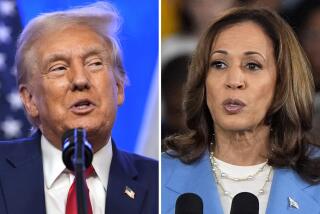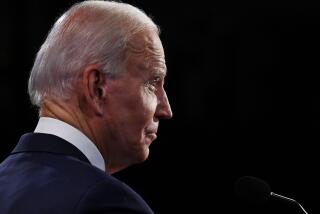Obama and Congress in sync
WASHINGTON — As chairman of his party’s congressional campaign committee, Rahm Emanuel helped scores of current House Democrats win their seats. When Tom Daschle was the Senate Democratic leader, he funneled more than $1 million to a new generation of lawmakers seeking office.
Now, as key members of Barack Obama’s incoming administration, Emanuel and Daschle are using their clout to help build sturdy bridges between the White House and Congress, coordinating their plans well before Inauguration Day.
That effort could produce a remarkable result: Democrats may try to pass an economic stimulus bill before Obama takes office Jan. 20, and have it on his desk to sign immediately. Typically, a new Congress spins its wheels for weeks while awaiting the arrival of a new president after convening in early January.
“We don’t intend to stumble into the next administration,” Obama said this week. “We are going to hit the ground running. We’re going to have clear plans of action.”
To that end, emissaries of the president-elect are meeting with every congressional committee chair. Emanuel, who will be Obama’s chief of staff, has been dispatched to the Capitol. And Obama, who is running the transition from his home base in Chicago, has been working the phones.
When Rep. Henry A. Waxman (D-Beverly Hills) won a bitter contest last week to become the next chairman of the House Energy and Commerce Committee, Obama called his cellphone to congratulate him. Almost daily, top Obama aides contact House Speaker Nancy Pelosi’s office, where Emanuel and others on the president-elect’s team have long-standing relationships with her chief of staff, John Lawrence.
“We can speak in political shorthand,” Lawrence said. “Conversations can be short and direct. We have a no-[deception] zone in the relationship.”
The incoming administration also has made an effort to reach across the aisle. Emanuel met with House and Senate Republican leaders last week. Obama has consulted with Republican lawmakers about his economic plans.
Members of Congress and their staffs say that the Obama team has been engaged in fact-gathering on the Hill as much as seeking support for its own agenda. That stands in marked contrast to the approach of Obama’s Democratic predecessors.
Bill Clinton and Jimmy Carter identified themselves as Washington outsiders, coming to the capital from Southern statehouses and having few connections to the Washington establishment. Their top White House appointees came from their home states of Arkansas and Georgia.
Early on, Carter drew congressional ire for attacking lawmakers’ beloved local projects, which he called wasteful pork-barrel spending. An aide at the time warned Carter that lawmakers considered him “naive or selfish or stubborn, or all three,” according to a biography of then-Democratic House Speaker Thomas P. “Tip” O’Neill Jr. by John Farrell.
And even though Democrats dominated both ends of Pennsylvania Avenue when Clinton took office, relations were so sour that the House did not give so much as a subcommittee vote to his signature healthcare initiative. Clinton developed the ambitious plan in a closed-door process that left senior lawmakers feeling excluded and disrespected.
His 1993 budget passed by the narrowest of margins. Two years into the Clinton administration, his party lost control of Congress.
Obama, who served less than four years in the Senate, is bringing substantial Capitol Hill experience to the White House in Emanuel and Pete Rouse -- a former aide to both Daschle and Obama who will be a senior advisor to the new president.
To serve as his congressional liaison, Obama has appointed Phil Schiliro, a former aide to Waxman and Daschle. Daschle, who is expected to be named Health and Human Services secretary, will probably play a large role in moving health legislation through Congress.
In addition, Obama this week named Peter R. Orszag, head of the Congressional Budget Office, to be White House budget director. And he tapped Rob Nabors, the top staffer on the House Appropriations Committee, as deputy budget director.
“It really is quite a collection,” said Stephen Hess, a Brookings Institution scholar who was a White House aide to President Eisenhower. “It doesn’t look like past teams, in part because there hasn’t been a president out of Congress in a long time.”
Hess said one risk of having so many advisors steeped in Capitol Hill culture was that they might be too aware of political potholes ahead -- which could dampen ambitions.
“Typically, people on the Hill know all the ways that nothing can happen,” Hess said. “They tend to advise the president, ‘You can’t get away with that.’ ”
--
cparsons@tribune.com
--
(BEGIN TEXT OF INFOBOX)
Noteworthy transitions
Since 1797, when George Washington handed over the presidency to John Adams in the first transition, transfers of executive power in the U.S. have sometimes gone smoothly, often been bumpy, and sometimes verged on catastrophic. Against that backdrop, the handoff of power from President Bush to President-elect Barack Obama already stands out for at least two reasons: Bush’s readiness to cooperate with his young successor, and the near-record speed and precision with which Obama has named his team and outlined a sweeping agenda for dealing with the worst economic crisis in a generation. Here are some noteworthy past transitions:
Thomas Jefferson, 1800-01
Among the most important transitions in American history, Jefferson’s ascension to the White House came after what remains one of the bitterest, most vitriolic U.S. presidential campaigns. The first transfer of power between political parties, it also represented a democratic turn away from rule by the young nation’s aristocratic elite. But instead of trying to heal the wounds, John Adams turned the transition into a display of personal pique -- refusing even to accompany Jefferson to the Capitol for the inauguration. Nonetheless, Jefferson, known for the idealism and soaring rhetoric of the Declaration of Independence, quickly showed himself to be a master of practical politics, and Adams’ once-dominant Federalist Party soon vanished into history. Obama is not likely to sweep the modern Republican Party from the stage, but he aspires to be a transformational figure nonetheless.
Abraham Lincoln, 1860-61
Arguably the most catastrophic transition in American history. With the country sliding toward civil war, outgoing President James Buchanan sat passively as state after state seceded from the Union -- making armed conflict all but unavoidable for the new president. The march of events became more disastrous because Lincoln, unlike fellow Illinoisan Obama, who is to be sworn in Jan. 20, did not take the oath of office until March 4. By then, seven states had left the Union and the stage was set for a conflict that would claim the lives of more than 600,000 Americans before peace and the Union were restored in 1865.
Franklin D. Roosevelt, 1932-33
With the nation suffering through the Great Depression, Roosevelt rebuffed what he saw as an effort by President Herbert Hoover to bind him to failed policies. The country’s economic pain increased during the transition, but FDR entered the White House unencumbered as the Democratic Congress joined in approving an almost unprecedented array of new programs -- some successful, others not -- aimed at setting America on the road to recovery. As candidates, Roosevelt and Obama both called for change. But where FDR promised to sweep aside the old political order, Obama promised to create a new era of reduced partisanship. Accordingly, he has created a virtual shadow government but avoided conflict with the outgoing administration of George W. Bush.
Ronald Reagan, 1980-81
A successful transition if ever there was one. Reagan may have run as an outsider determined to challenge the status quo in the nation’s capital, but he came into office with a White House team that was loyal and savvy in the ways of Washington and “hit the ground running.” In short order, they drove a high-profile agenda of tax cuts and other measures through Congress. Reagan may have benefited from the miscues of his predecessor, Jimmy Carter, who also ran as an outsider but surrounded himself with aides who had little Washington experience, and paid a stiff price in diminished effectiveness.
Bill Clinton, 1992-93
Sluggishness and disorganization marred the process of assembling a Clinton team, with the president-elect focusing more on high-profile Cabinet appointments than on selecting a White House staff and establishing a clear decision-making process. Whereas Obama quickly tapped Rahm Emanuel to be his chief of staff, Clinton did not make the crucial appointment until mid-December, and a number of top staff people were not named until a week before Inauguration Day. The early disarray may have contributed to political missteps that shook Clinton’s first term, including a politically damaging and ultimately unsuccessful attempt to end the ban on gays in the military and a disastrous attempt to create a sweeping healthcare reform plan without consulting Congress or stakeholders. Whether Obama can avoid early miscues remains to be seen, but he seems to be approaching the transition with exceptional discipline and dispatch.
-- Cynthia Dizikes
Sources: Alvin Felzenberg: “The Transition: A Guide for the President-elect”; John P. Burke: “Lessons from Past Presidential Transitions”; and Martha Joynt Kumar, a Towson University political science professor and director of the White House Transition Project.
More to Read
Get the L.A. Times Politics newsletter
Deeply reported insights into legislation, politics and policy from Sacramento, Washington and beyond. In your inbox three times per week.
You may occasionally receive promotional content from the Los Angeles Times.












